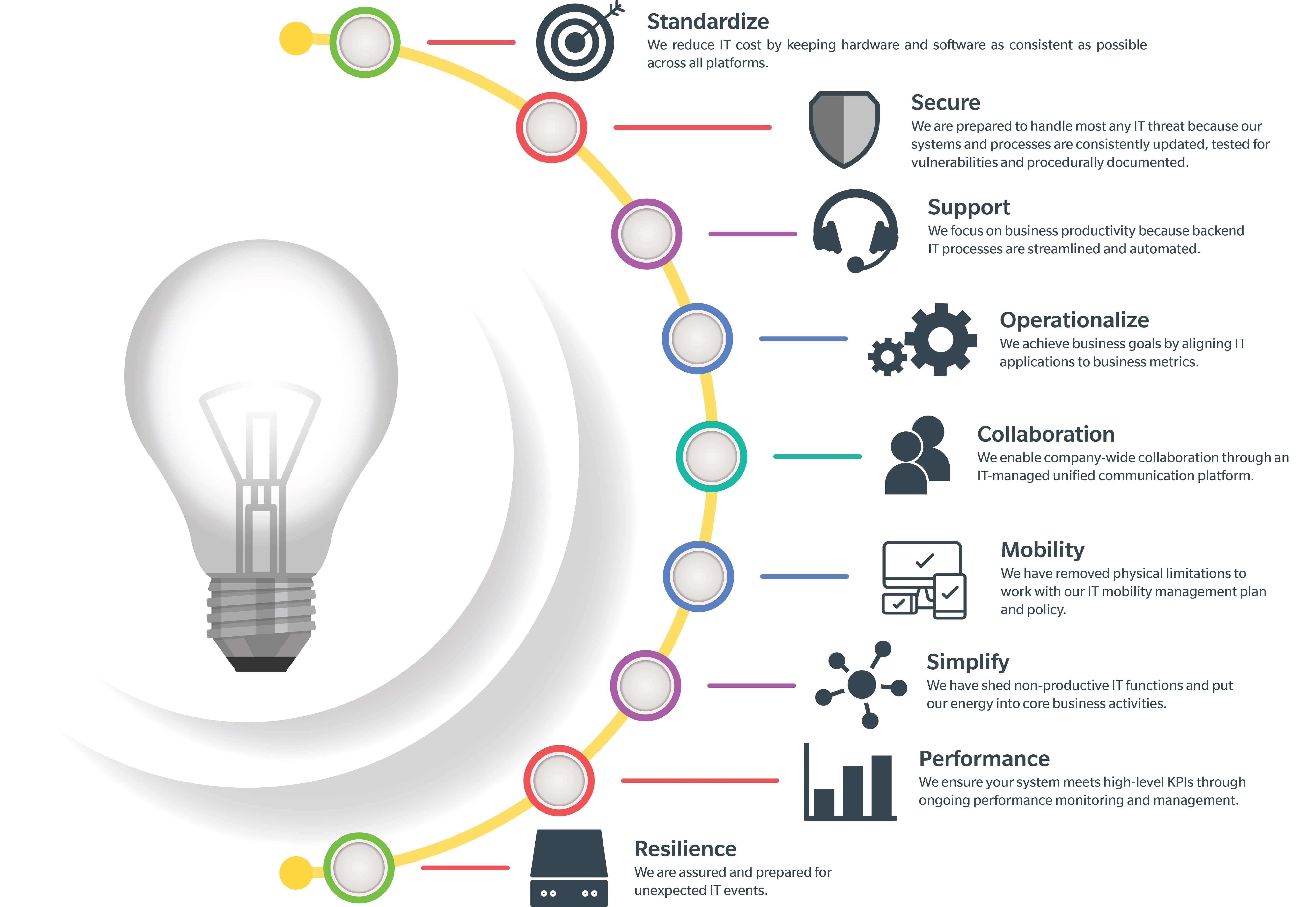This is the final blog in a four-part series that will help you create a roadmap for your journey to build and maintain a better IT system. [Part 1], [Part 2], [Part 3].
Where Have We Been?
Over the past few weeks we have travelled together on a journey to create and improve IT systems that are suited for the changing workplace. Identifying relevant milestones will help you organize your journey into manageable steps. These milestones can then be organized into phases to provide clear areas of focus. Konica Minolta has identified 9 milestones for its IT Journey that have been organized into three phases: Set-Up, Improvement, and Lifetime Enhancement.
Our previous blogs have discussed the Set-Up and Improvement phases. The final phase to cover on our journey ensures our IT systems will stand against the test of time with simplification, performance, and resilience.
IT Simplification
Non-core activities should not require more resources than strictly necessary. Simplifying your IT requires you to be able to identify which activities are core and which are not. If you have been following along on our journey, you should have a pretty comprehensive understanding of your IT system.
Being able to identify the most important activities that are covered by your IT system is the first step toward understanding how best to allocate your resources. Discover what resources are required for each process and identify any areas in which resources are under or overallocated.
Simplifying your IT systems will also serve to divert any unnecessary spending to focus more on revenue-generating activities.
IT Performance
Strong performance of your IT system stems from proper monitoring, measurement, and management of your systems. Independent of the granular monitoring that was discussed in the IT Operationalization milestone, performance monitoring should consist of broad KPIs. The specific KPIs that are used will be unique for every business, they should always consist of a mix of financial and nonfinancial measures.
The goal of this milestone on your IT Journey is to identify the measures that will best provide a holistic view of the company performance from an IT perspective. Keeping a consistent level of attention on performance measurement will assign a degree of accountability to these KPIs. Higher awareness of performance helps you to proactively address issues and reduces the amount of lag and downtime associated with IT maintenance and repairs.
Some KPIs to consider monitoring include:
- Operational targets (from Service-Level Agreements and Service-Level Objectives);
- Project delivery and defects;
- Financial health indicators (Total Cost of Ownership, Return on Investment);
- Organizational effectiveness and responsiveness.
IT Resilience

The final milestone on our IT Journey concerns resiliency, and it is not one that can be rushed through. Like everything else we have discussed, IT resilience is a crucial component of this journey. It is your ability to withstand any kind of service continuity interruption and maintain acceptable IT service levels, no matter what challenges arise. Like your staff, your system must be prepared to endure anything with a fast and full recovery.
Unplanned systems-related downtime can be damaging to your business, causing loss of revenue that can be unrecoverable. The cost of system failures can extend beyond revenue loss to affecting employee productivity long after the initial incident. IT resilience is an action plan to deploy resources with urgency and purpose, regardless of the size of the incident.
Apart from natural disasters that cannot be predicted, IT related issues are typically caused by several factors that have built up over time. With proper performance monitoring, the goal is that these factors will be caught and addressed before they have a chance to spill over. However, there will always be cases where issues slip between the cracks. In these cases, it is essential to have built up the resilience of your system.
Developing and implementing a comprehensive IT disaster recovery plan (DRP) with a corresponding business continuity management (BCM) policy and plan contributes greatly to your resilience. Be sure to incorporate formal risk assessments in the development of these plans, reviewing third party security and infrastructure associated with key business activities.
Keeping these plans up to date is important to ensure the resilience of your system is long-lived. Periodically test your DRP to make sure it can be successfully executed in the case of an emergency. These tests should occur in simulated environments, so that they do not affect day-to-day activities. Testing the plan will ensure that all management and staff understand their roles and responsibilities and helps identify areas in which it may be improved.
Final Thoughts
This series has shared with you the path that Konica Minolta has identified for its IT Journey. This may be a good fit for your business, or you may find that additional milestones are needed to better develop your system. The goal of these blogs has been to educate you on the importance of embarking on an IT Journey and identify elements that should be considered along the way. With this series as a guide, we hope that you can reinforce your IT to keep your business relevant and future ready.
